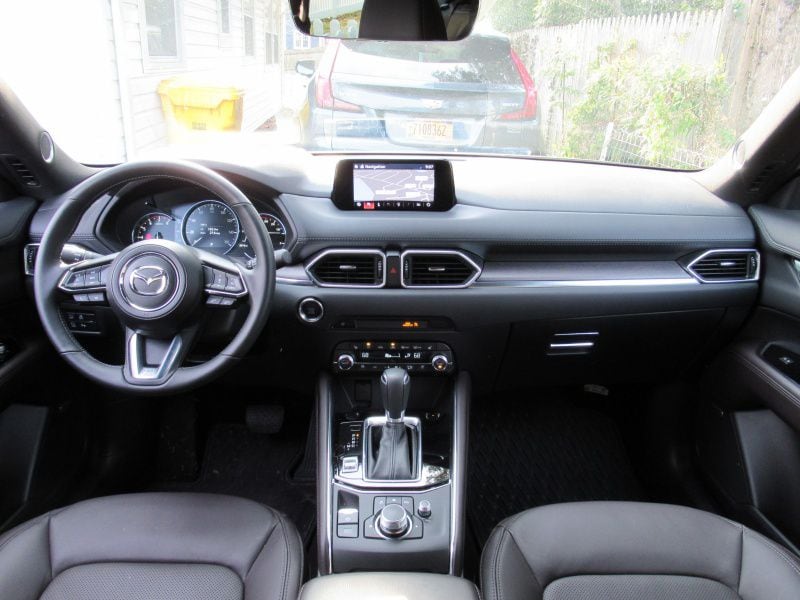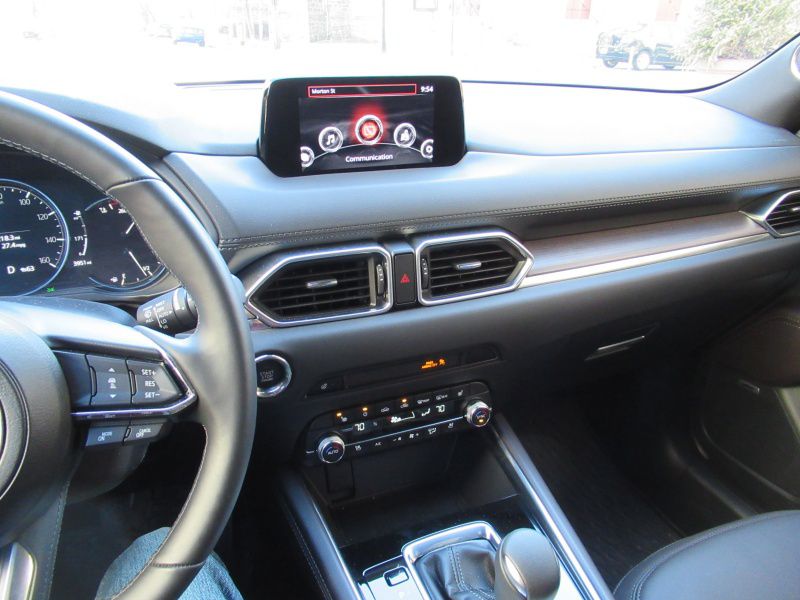Recent Articles
Popular Makes
Body Types
2019 Mazda CX-5 Road Test and Review

2019 Mazda CX 5 front view ・ Photo by Brady Holt
Ever since its first generation appeared as a 2013 model, the Mazda CX-5 compact crossover has been a favorite among driving enthusiasts. Sure, it didn’t match the function-focused Honda CR-V or Toyota RAV4 for maximum interior volume. But the CX-5 won fans for blending the good looks and fun-to-drive handling of a Mazda with the practicality of an SUV. The current CX-5 generation, which followed in 2017, refined and enhanced the original formula.
There was just one problem: Some folks still pined for extra oomph. The CX-5 had become a beautiful, premium-feeling crossover with the ability to delight drivers — but it didn’t have the horsepower to outgun the RAV4 and CR-V in a straight line. That’s changed with the updated 2019 Mazda CX-5, whose newly available turbocharged engine brings a welcome jolt of energy. At the same time, new high-end trim levels double down on the model’s luxury aspirations. Let’s go over the details of this appealing crossover.
Prices and Trims
Prices for the 2019 Mazda CX-5 start at $24,350 for the base Sport model. That’s competitive in the compact crossover segment, particularly given that its standard equipment includes many features that cost extra on key competitors. These include alloy wheels, LED headlights, blind-spot monitoring with rear cross-traffic alert, low-speed automatic emergency braking, a touchscreen infotainment system, an electronic parking brake, and keyless entry with push-button start.
But the real steal of the CX-5 lineup is the $26,615 Touring, which adds heated and power-adjustable leatherette seats, automatic climate control, Android Auto and Apple CarPlay smartphone integration, and even rain-sensing windshield wipers, plus more safety gear. That gives you most of the feel of a fully loaded vehicle at a price well below $30,000. For even more dazzle and some extra goodies, Mazda also offers the true-leather Grand Touring ($30,045), plus the even higher-end Grand Touring Reserve ($34,870) and Signature ($36,890).

Photo by Brady Holt
New Luxury Models
The Grand Touring Reserve and Signature models are both new for the 2019 Mazda CX-5. Previous model years topped out at the Grand Touring. These two new trim levels are available only in all-wheel drive and with the new turbo engine. They also bring an even higher grade of feature content. The Reserve starts by adding ventilated front seats and heated rear seats, a heated steering wheel, and traffic sign recognition capabilities.
It’s the Signature, though, that puts forth the best challenge to a luxury car. In addition to simply having more features — front and rear parking sensors and a surround-view parking camera system — it brings other upgrades to make it by far the fanciest CX-5 ever sold. These include Nappa leather upholstery, genuine wood trim, a black fabric headliner, an elegant frameless rearview mirror, and LED cabin lighting. We tested a Signature model that reached $39,155 with its destination charge, a coat of extra-cost Machine Gray Metallic paint, and several small add-ons.

Photo by Brady Holt
Turbocharged Power
Most 2019 CX-5 models continue to use last year’s 2.5-liter 187-hp four-cylinder engine, which balances decent acceleration, decent fuel economy, and decent quietness. It manages EPA ratings of 25 miles per gallon in the city, 31 mpg on the highway, and 28 mpg overall with front-wheel drive, and about 1 to 2 mpg less with all-wheel drive. That’s not bad for an SUV, though many competitors do even better. The same can be said for this engine’s acceleration and noise levels.
The new 2.5-liter turbo changes that. The same engine used in the bigger Mazda CX-9 crossover, it cranks out a healthy 250 hp and 310 lb-ft of torque (on premium fuel). That’s more than most mainstream-brand competitors, along with luxury models like the Audi Q5 and Lexus NX. The result: brisk performance accompanied by an effortless-sounding whir. EPA ratings slip to 24 mpg in mixed driving, but that’s competitive with similarly powerful crossovers. What’s more, the CX-5 turbo still can achieve a healthy 227 hp on affordable regular-grade fuel.

Photo by Brady Holt
Sprightly Handling
Regardless of the engine you choose, every 2019 Mazda CX-5 is among the sharpest-handling crossovers to wear a mainstream badge — and it’s even on par with some luxury models. The CX-5’s quick, responsive steering can help you forget you’re driving a roomy SUV. What’s more, unlike many sporty cars, you don’t have to endure a stiff, punishing ride to get capable handling; while the CX-5 isn’t the smoothest-riding compact crossover you can buy, it certainly remains pleasant.
Helping out even further is Mazda’s unique G-Vectoring Control, which subtly adjusts the engine power distribution to help guide the car smoothly around a corner or in a straight line. These behind-the-scenes operations help the driver avoid tiresome steering corrections. The CX-5’s optional all-wheel-drive system also is impressive, frequently scoring among the best in the class for tackling snowy conditions.

Photo by Brady Holt
Upscale Design
The 2019 Mazda CX-5 is a lovely vehicle that eschews flashy details but still manages to look both sporty and luxurious, particularly from the front end. We’ll credit the slim headlights and the hunched-forward silhouette, along with designers' avoidance of trendy bulges and creases that can look busy when overdone.
The interior design also benefits from its simplicity. As on other Mazdas, infotainment controls occupy the center console between the front seats, which de-clutters the dashboard. Most materials are appropriately upscale, particularly on the Signature model we tested, even if they won’t embarrass an Audi. However, while the CX-5’s infotainment system now supports Android Auto and Apple CarPlay on most trim levels, the 7-inch screen is starting to look pretty small for 2019. That’s especially true as the CX-5 starts to play in the luxury segment, where several models have 10-inch-plus displays.

Photo by Brady Holt
Decent Interior Room
The CX-5 brings the inherent utility of the five-door compact crossover design: an elevated driving position, room for five passengers, and a useful amount of cargo room. The latter includes 30.9 cubic feet of volume behind the rear seat, and 59.6 cubic feet with the rear seat folded down. And unlike most competitors, the rear seat folds in a handy 40-20-40 split instead of a simple 60-40. Mazda’s seat-folding approach gives you more flexibility to squeeze in extra cargo along with your passengers.
That said, many competitors have more sheer volume. Their boxy shapes aren’t as beguiling as the CX-5’s, but models like the Honda CR-V, Nissan Rogue, and Toyota RAV4 have extra rear legroom and additional cargo capacity — up to 25 percent more cargo room — that some buyers will welcome. These models are slightly longer, and they’re packaged to have lower cargo floors than the Mazda. Many buyers will fit just fine in the CX-5, but if you’re regularly carrying adults in the rear seat or you’re hitting up Ikea every other weekend, carefully consider the Mazda’s tighter size.

Photo by Brady Holt
Strong Safety
The Mazda CX-5 demonstrated exemplary crash-test performance. It achieved the highest Top Safety Pick+ designation from the Insurance Institute for Highway Safety, along with the highest score of five stars from the National Highway Traffic Safety Administration.
It also comes with generous crash-avoidance equipment, even on the base model: low-speed emergency automatic braking, a blind-spot monitoring system, a rear cross-traffic alert, and a backup camera. The rest of the CX-5 line even adds radar cruise control, high-speed emergency automatic braking, a lane-departure warning, and automatic lane-keeping steering corrections. And the top Signature adds a surround-view camera that shows you a bird’s-eye view of the CX-5, lane markings, and any obstacles, helping you perfectly position the vehicle in low-speed maneuvers.

Photo by Brady Holt
Varied Competition
Because it’s more luxurious and more fun to drive than most mainstream compact crossovers, the 2019 Mazda CX-5 has a variety of competitors. The most obvious choice is the Honda CR-V, which not only is one of the class’s best-sellers, but it’s also another option with above-average handling. But while the CR-V is roomier and more fuel-efficient than the CX-5, the Honda doesn’t have the same thoroughly fun and fancy flavor as the Mazda, and it can’t upgrade to an extra-powerful engine.
Three impressive compact crossovers with available 200-plus-horsepower turbocharged engines are the Chevrolet Equinox, GMC Terrain, and Ford Escape. The Equinox and Terrain are polished and comfortable but not as overtly sporty as the CX-5, and they can get expensive quickly. The Escape is affordable and fun to drive, but this aging model (in its final months before a 2020 redesign) trails the Mazda’s safety, fuel economy, and interior decor. Lastly, upper-trim CX-5 models are worth shopping against premium crossovers like the Audi Q5, Infiniti QX50, Lexus NX, or Volvo XC40 — Mazda might pleasantly surprise you for its blend of high-end features, driving pleasure, everyday comfort and utility, and relative affordability.

Photo by Brady Holt
Affordable Luxury
If you’re shopping for a simple, functional, comfortable compact crossover, you may wonder what’s so great about the CX-5. After all, you can get competitors with more interior space, better gas mileage, smoother rides, and bigger infotainment screens.
But unless you spend well over $35,000, it’s tough to find a crossover that looks this good or drives this well — especially if you choose the powerful new turbo engine. It can pass for a luxury vehicle, even when it's cost-competitive with everyday mainstream models. If that sounds appealing to you, don’t miss the newly improved 2019 Mazda CX-5.

Photo by Brady Holt